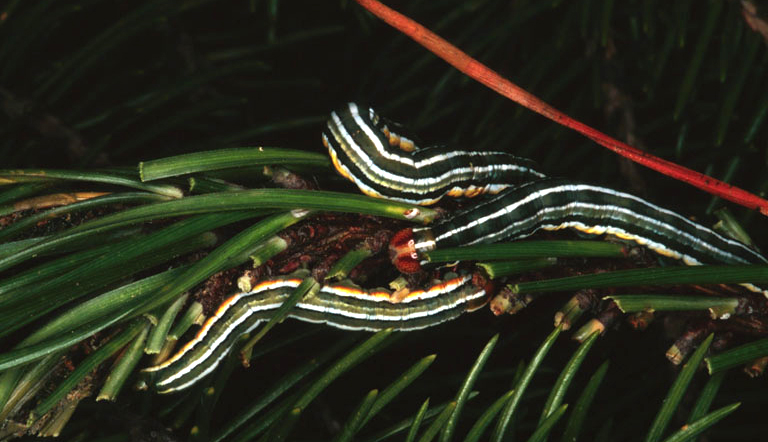pine beauty on:
[Wikipedia]
[Google]
[Amazon]
The pine beauty (''Panolis flammea'') is a moth of the family 

 The forewings are typically rich orange brown, but sometimes are dark grey, with two large pale stigmata and fine streaks along the termen. The hindwings are brown or blackish.
The forewings are typically rich orange brown, but sometimes are dark grey, with two large pale stigmata and fine streaks along the termen. The hindwings are brown or blackish.
Funet
Taxonomy *
Lepiforum.deVlindernet.nl
{{Taxonbar, from=Q46160 Panolis Moths described in 1775 Moths of Europe Moths of Asia
Noctuidae
The Noctuidae, commonly known as owlet moths, cutworms or armyworms, are a family of moths. They are considered the most controversial family in the superfamily Noctuoidea because many of the clades are constantly changing, along with the other f ...
. It is a common species of pine woods in Europe. The distribution area extends from the west of Catalonia over southern France
Southern France, also known as the South of France or colloquially in French language, French as , is a defined geographical area consisting of the regions of France that border the Atlantic Ocean south of the Marais Poitevin,Louis Papy, ''Le midi ...
, central Italy, central Europe to western Siberia, the Caucasus and Asia Minor. In the north it extends to the Arctic Circle, in the south it is found on the northern Iberian Peninsula and southern Italy (including Sicily and Sardinia).


 The forewings are typically rich orange brown, but sometimes are dark grey, with two large pale stigmata and fine streaks along the termen. The hindwings are brown or blackish.
The forewings are typically rich orange brown, but sometimes are dark grey, with two large pale stigmata and fine streaks along the termen. The hindwings are brown or blackish.
Technical description and variation
The wingspan is 32–40 mm. Forewing orange rufous with some ochreous admixture; the veins dotted grey and white; the inner and outer lines deeper rufous, conversely edged with white, and dentate lunulate; submarginal line pale, preceded by a dentate rufous shade; the terminal area often paler; stigmata large, irregular; the claviform with some pale and brown scales at its extremity; orbicular and reniform pale rufous with deeper centres, the orbicular flattened, its lower edge often produced along median vein as a streak and connected with reniform, which is large with the upper end angularly produced outwards; fringe mottled rufous and white hindwing fuscous, often with a reddish tinge; the ab. ''griseovariegata'' Goeze has the rufous tints obscured by glaucous grey and fuscous.Biology
This moth flies at night from March to May and is attracted to light and sallow blossom. Larva bright green with the lines broadly white edged with deep green; spiracular line edged below with yellow. It feeds on the needles of ''Pinus sylvestris'' and other pines, but sometimes on other trees (see list below), and can be a seriouspest
Pest or The Pest may refer to:
Science and medicine
* Pest (organism), an animal or plant deemed to be detrimental to humans or human concerns
** Weed, a plant considered undesirable
* Infectious disease, an illness resulting from an infection
** ...
in forests. The species overwinters as a pupa.
#''The flight season refers to the British Isles. This may vary in other parts of the range.''
Recorded food plants
*''Abies'' –fir
Firs (''Abies'') are a genus of 48–56 species of evergreen coniferous trees in the family (biology), family Pinaceae. They are found on mountains throughout much of North America, North and Central America, Europe, Asia, and North Africa. The ...
*''Betula'' – birch
*''Chamaecyparis
''Chamaecyparis'', common names cypress or false cypress (to distinguish it from related cypresses), is a genus of conifers in the cypress family Cupressaceae, native to eastern Asia (Japan and Taiwan) and to the western and eastern margins of th ...
''
*''Juniperus'' – juniper
Junipers are coniferous trees and shrubs in the genus ''Juniperus'' () of the cypress family Cupressaceae. Depending on the taxonomy, between 50 and 67 species of junipers are widely distributed throughout the Northern Hemisphere, from the Arcti ...
*''Larix'' – larch
*''Picea'' – spruce
A spruce is a tree of the genus ''Picea'' (), a genus of about 35 species of coniferous evergreen trees in the family Pinaceae, found in the northern temperate and boreal (taiga) regions of the Earth. ''Picea'' is the sole genus in the subfami ...
*''Pinus'' – pine
*''Pseudotsuga'' – Douglas-fir
*''Quercus'' – oak
See Robinson, G. S. et al.
References
*Chinery, Michael ''Collins Guide to the Insects of Britain and Western Europe'' 1986 (Reprinted 1991) *Skinner, Bernard ''Colour Identification Guide to Moths of the British Isles'' 1984External links
Funet
Taxonomy *
Lepiforum.de
{{Taxonbar, from=Q46160 Panolis Moths described in 1775 Moths of Europe Moths of Asia